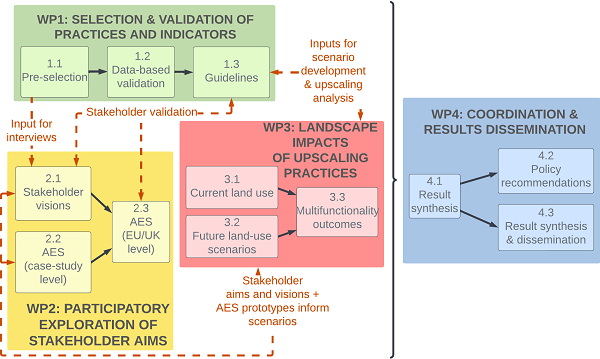Project Overview
Globally, agriculture faces unprecedented challenges: feeding a growing and more affluent world population, restoring biodiversity and mitigating and adapting to climate change. The historic focus on food production has resulted in the intensification, simplification and degradation of agricultural systems, threatening the resilience of our food production system. Future agricultural landscapes need to be multifunctional and resilient, delivering a wide range of agroecosystem services in addition to food production. When efforts are made to promote agrobiodiversity, food production, biodiversity and climate change goals are reordered and sustainably managed.
In Clear Project, we will identify integrative landscape-level collaborative planning approaches to incentivize the widespread adoption of agrobiodiversity-enhancing measures.
The CLEAR Project aims to develop and apply an interdisciplinary methodological framework for data-and stakeholder-based identification and evaluation of practices enhancing agrobiodiversity, including collaborative landscape-level approaches. Through this integrative approach, we anticipate prioritizing integrating agri-environmental and socioeconomic perspectives based on site-specific data from case studies of the four participating partner countries in France, Germany, Poland, and the UK.
CLEAR proposes a novel approach for landscape-level decision-making based on the identification of links between diversification practices,
In CLEAR Project, four participating institutions from four countries will be using their expertise in agricultural landscape modeling, stakeholder engagement, and biodiversity assessment to achieve system-based methods and tools for assessing agrobiodiversity and its outcomes at the landscape level, scenarios integrating stakeholder aims with diversified agricultural system configurations, and novel designs of agri-environmental schemes to maximize multifunctional and resilient agricultural landscapes that reconcile agrobiodiversity conservation and food security under global change
Project aims and goals
The CLEAR project seeks to evaluate agricultural diversification practices, its impacts on agrobiodiversity and derived agroecosystem services, and their potential for upscaling.
The project aims to:
- Identify practices that enhance agrobiodiversity across EU/UK contexts, considering natural and societal requirements for landscape-scale upscaling.
- Identify indicator metrics to monitor agrobiodiversity and related agroecosystem services and increase the understanding of scientific and practical requirements for adoption.
- Develop a data- and stakeholder-based methodological framework to facilitate spatial targeting and collaborative planning to enhance landscape multifunctionality.
- Propose effective agri-environmental measures to incentivize uptake of practices enhancing agrobiodiversity and resilience at farm and landscape level, considering opportunities and limitations for collaborative and result-based approaches across the EU/UK.

The goal is to characterize, measure, and incentivize agrobiodiversity to enhance resilience and multifunctionality across farms, from field to landscape level.
Project expected outcomes
The CLEAR project's expected outputs are
- Identification of key practices targeting agrobiodiversity enhancement at the field to landscape scale;
- Selection of indicator metrics that can be applied to evaluate the impacts of diversification practices at the landscape scale;
- Development of a guiding methodology to select and measure agrobiodiversity and its effects in other EU regions; and
- Identification of opportunities for policy measures that incentivize agrobiodiversity practices via collaborative landscape planning
Workflow and interlinkages
CLEAR envisions a highly iterative research framework that relies on intensive feedback among the planned WPs. The Clear project will evaluate agricultural diversification practices and indicators expressing the effects of these practices on the provision of agroecosystem services based on existing scientific data (WP1) and stakeholder feedback (WP2). The most promising agrobiodiversity practices (from WP2) are then identified for future uptake and upscaling concerning their spatial land use configuration and composition (WP3). The project dissemination of findings and recommendations are targeted in WP4. The WPs are assigned leads & co-leads to encourage cross-regional research integration and strengthen partner collaborations.



 DE
DE  FR
FR  PL
PL 
